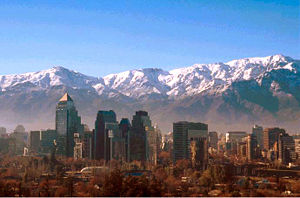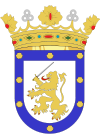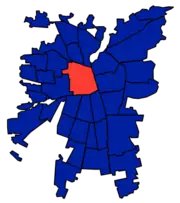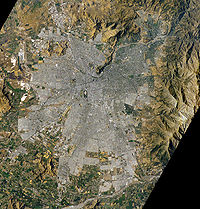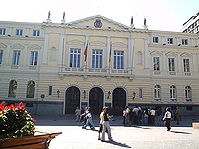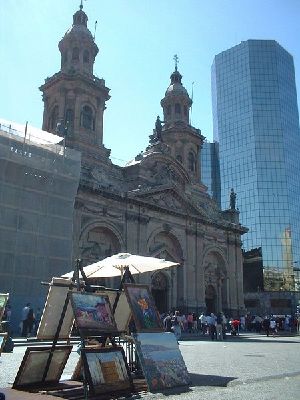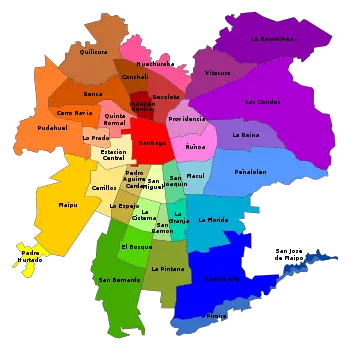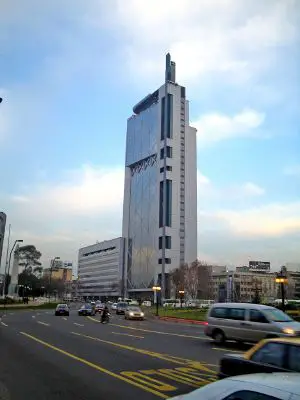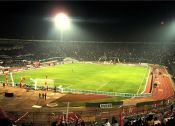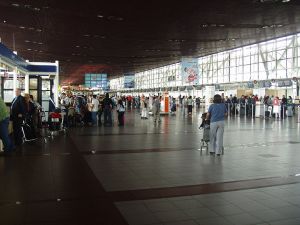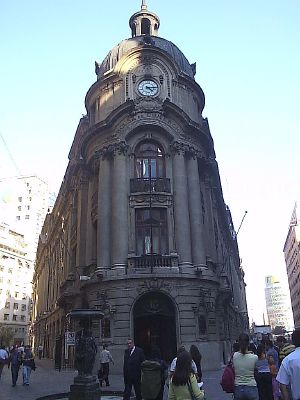Difference between revisions of "Santiago, Chile" - New World Encyclopedia
| Line 342: | Line 342: | ||
*Museo de la Solidaridad "Salvador Allende" | *Museo de la Solidaridad "Salvador Allende" | ||
*[http://www.palaciocousino.cl Palacio Cousiño] | *[http://www.palaciocousino.cl Palacio Cousiño] | ||
| + | |||
| + | |||
| + | ===Sport↑=== | ||
| + | [[Image:Estadio Nacional de Chile.jpg|thumb|175px|left|[[National Stadium]]]] | ||
| + | Football (soccer), rugby union and tennis are popular sports throughout Chile and Santiago is no exception. Football (soccer) is the most popular sport in Chile. The Chile national football team represents Chile in all major international football competitions. The team is controlled by the Federación de Fútbol de Chile and was established in 1895. They have appeared in seven FIFA World Cup tournaments culminating in their third place finish when they hosted the tournament in 1962, and a Bronze medal in the 2000 Summer Olympics in Sydney, Australia. Satiago's Estadio Nacional de Chile has hosted the 1962 FIFA World Cup Final and the 1987 FIFA World Youth Championship and 4 Copa America finals. | ||
| + | |||
| + | The traditiona pasttime of Chilean rodeo was declared a national sport of Chile in 1962. The Chilean is very different to the North American rodeo, with a greater emphais on exceptional horsemanship. The Chilean rodeo is conducted in half moon arenas similar to corrals called the Media Luna. A steer enters the Media Luna and runs in one direction, while the competitors, or huasos, compete in teams of two and must pin the steer against the side of the arena and turn it in the opposite direction. The efficiency of the execution of the turn and huasos' "form" determines their overall score. Points are added and deducted for each turn and the competition when the huasos have turned the steer three times. Chilean rodeos involve the entire community and are a festive celebration with a carnival like atmosphere and plenty of music, dancing and food | ||
| + | <ref> Expediciones Chile [http://exchile.com/ChileanRodeo.html The Chilean Rodeo ] Retrieved October 21, 2007.</ref> | ||
| + | |||
| + | Main Sport Venues: | ||
| + | *[[Estadio Nacional de Chile|Estadio Nacional]] (site of the [[1962 FIFA World Cup|1962 World Cup]] final) ''65.000 all-seated'' | ||
| + | *[[Estadio Monumental David Arellano]] ''62.000 all-seated'' | ||
| + | *[[Estadio Santa Laura]] ''28.500 all-seated'' | ||
| + | *[[Estadio San Carlos de Apoquindo]] ''20.000 all-seated'' | ||
| + | |||
| + | ===Religion↑=== | ||
| + | [[Image:Templo Votivo de Maipú 2.jpg|thumb|left|''Templo Votivo de [[Maipu]]'']] | ||
| + | |||
| + | Most of Chile's population is nominally [[Catholic]] and Santiago is no exception. According to the National Census, carried out in 2002 by the National Statistics Bureau ([[Instituto Nacional de Estadística|INE]]), in the Santiago Metropolitan Region, 3,129,249 people 15 and older identified themselves as Catholics, equivalent to 68.7% of the total population, while 595,173 (13.1%) described themselves as [[Evangelicals|Evangelical Protestants]]. Around 1.2% of the population declared to be [[Jehovah's Witnesses]], while 0.9% identified themselves as [[Latter-day Saints]] (Mormons), 0.25 as [[Jewish]], 0.03 as [[Muslims]] and 0.11 as [[Orthodox Church|Orthodox Christians]]. Approximately 10.4% of the population of the Metropolitan Region stated that they were [[atheist]] or [[agnostic]], while 5.4% declared to follow other religions..<ref>Instituto Nacional de Estadística(INE), Chile [http://www.ine.cl/cd2002/index.php 2002 Census]</ref> | ||
==Infastructure== | ==Infastructure== | ||
| Line 373: | Line 392: | ||
| − | |||
| − | |||
| − | |||
| − | |||
| − | |||
| − | |||
| − | |||
| − | |||
| − | |||
| − | |||
| − | |||
| − | |||
| − | |||
| − | |||
| − | |||
| − | |||
| − | |||
| − | |||
| − | |||
==Sister Cities== | ==Sister Cities== | ||
Revision as of 01:22, 22 October 2007
| Santiago de Chile | |||
| Santiago, Chile and the snowed Andes mountain in the background | |||
|
|||
| Location of Santiago commune in Greater Santiago | |||
| Coordinates: {{#invoke:Coordinates|coord}}{{#coordinates:33|27|0|S|70|40|0|W|type:city | |||
|---|---|---|---|
| name= }} | |||
| Region | Santiago Metropolitan Region | ||
| Province | Santiago Province | ||
| Foundation | February 12 1541 | ||
| Government | |||
| - Mayor | Raúl Alcaíno Lihn | ||
| Area 1 | |||
| - City | 22.4 km² (8.6 sq mi) | ||
| - Urban | 714.5 km² (275.9 sq mi) | ||
| Elevation | 520 m (1,700 ft) | ||
| Population (2002) | |||
| - City | 200,792 | ||
| - Metro | 6,402,552 | ||
| Time zone | Chile Time (CLT)[1] (UTC-4) | ||
| - Summer (DST) | Chile Summer Time (CLST)[2] (UTC-3) | ||
| 1 City = Santiago Centro, Urban = Greater Santiago | |||
| Website: municipalidaddesantiago.cl | |||
Santiago, officially Santiago de Chile (Template:Audio-es), is the capital of Chile, and the center of its largest conurbation (A predominantly urban region including adjacent towns and suburbs; a metropolitan area[3]) - Greater Santiago. It is situated at an elevation of 520 m (1700 ft) in the country's central valley. Although Santiago is the capital, legislative bodies meet in nearby Valparaíso.
Approximately two decades of uninterrupted economic growth have transformed Santiago into one of Latin America's most sophisticated metropolitan areas, with extensive suburban development, dozens of shopping malls, and impressive high-rise architecture. The city also boasts some of Latin America's most spectacular infrastructure, such as the Santiago Metro and the sparkling new Costanera Norte, a highway system that passes below downtown and connects the Eastern and Western extremes of the city in a 40-minute drive. Santiago is headquarters to many important companies and is a regional financial center.
Note
Throughout this article the term Santiago will normally refer to the Greater Santiago area; however, there are several other entities which bear the name of Santiago and need to be explained: The commune (comuna) of Santiago (sometimes referred to as Santiago Centro), is a subdivision of the Santiago Province, which is itself a subdivision of the Santiago Metropolitan Region. The commune is administered by the Santiago municipality (Municipalidad de Santiago), a separate legal entity with an elected mayor and council. It encompasses the oldest part of Greater Santiago, including downtown, and houses all major government infrastructure, including the government palace La Moneda. It has an area of 22.4 km² and a population of 200,792 (2002 census).
History

Santiago was founded by Pedro de Valdivia on February 12, 1541 on Huelén Hill (later renamed Cerro Santa Lucía). Valdivia chose the location of Santiago because of its moderate climate and the ease with which it could be defended — Mapocho River then split into two branches around Huelen hill, and rejoined further downstream, forming an island.
The city was destroyed on September 11, 1541 by the native forces under the chief Michimalonco, which led to the Arauco War.
The first buildings were erected with the help of the native Picunche Indians. The south bank of the Mapocho River was later drained and converted into a public promenade, known as the Alameda (now Avenida Alameda Libertador Bernardo O'Higgins, the city's main avenue). The city was slightly damaged during the War of Independence (1810–18), during the Battle of Maipú, which was fought south-west of the city. Santiago was named capital in 1818.
During the early 19th century, Santiago remained a small town with few buildings excepting Palacio de La Moneda, the building used as the Chilean mint during the Spanish period, and a few churches and other civic buildings. The Iglesia de la Compañía de Jesús caught fire during an 1863 church service, and 2000 people died, one of the worst modern fires.[4]
In the 1880s extraction of nitrate fertilizer in Northern Chile brought prosperity to the country, and promoted the capital city's development. Important landmarks were built in 1910 during the Centennial celebrations of independence from Spain, such as the National Library, the Museum of Fine Arts and the Mapocho Train Station (Estación Mapocho, now an events center).
Santiago began its transformation into a modern city in the 1930s, with the building of the Barrio Cívico, surrounding El Palacio de La Moneda. The city also grew in population, due to migration from the north and south of Chile. In 1985 an earthquake destroyed some historically significant buildings in the downtown area.
Nowadays, Santiago is among the largest and most important financial centers in Latin America, ranking high as a Global City.
Geography↑
Elevation
Santiago lies at 33' 27" South & 70' 40" West at an elevation of 522 meters (1,712 feet)[5]
The city lies in the center of the Santiago Basin, an enormous bowl-shaped valley consisting of a broad and fertile plain surrounded by mountains. It is flanked by the main chain of the Andes on the east and the Chilean Coastal Range on the west. On the north is bounded by the Cordón de Chacabuco, a transverse mountain range of the Andes, whereas at the southern border lies Angostura de Paine, a valley narrowing where an elongated spur of the Andes almost reaches the Coastal Range. Santiago Basin is part of the Intermediate Depression and is remarkably flat, interrupted only by a few hills. Among those are Cerro Renca, Cerro Blanco and Cerro Santa Lucía.
The Andes de Santiago are a massive mountainous system culminating in Tupungato volcano at 6,570 m (21,555 ft). Other volcanoes include Tupungatito, San José and Maipo. Cerro El Plomo is the highest mountain visible from Santiago urban area. The Mapocho River runs east to west through the city.
Santiago is divided into 13 political districts or comunas, with each having an elected mayor. The wealt and therefore the quality of life varies significantly among the comunas with the wealthier comunas having modern buildings and well-tended public areas. The poorer comunas usually have unpaved roads and inadequate housing.
Climate ↑
Santiago has a mild Mediterranean climate: relatively hot dry summers (November to March) with temperatures reaching up to 35 degrees Celsius (95 degrees Fahrenheit) on the hottest days; winters (June to August) are more humid, with typical maximum daily temperatures of 15 degrees Celsius (59 degrees Fahrenheit), and minimums of a few degrees above freezing. Occasional snowfall occur on higher suburbs of the city. Mean rainfall is 312.5 mm per year.[6]
Thermal inversion (a meteorological phenomenon where a layer of cooler air is trapped near the ground by a layer of warmer air above. When this occurs, normal air mixing almost ceases and pollutants are trapped in the lower layer)[7] causes high levels of smog and air pollution to be trapped and concentrate within the Central Valley during winter months.
| Weather averages for Santiago, Chile | |||||||||||||
| Month | Jan | Feb | Mar | Apr | May | Jun | Jul | Aug | Sep | Oct | Nov | Dec | Year |
|---|---|---|---|---|---|---|---|---|---|---|---|---|---|
| Avg high °C | 29.7°C | 29.1°C | 26.9°C | 23.3°C | 18.7°C | 15.2°C | 14.9°C | 16.7°C | 19.0°C | 22.3°C | 25.4°C | 28.4°C | 22.5°C |
| Avg low °C | 13.0°C | 12.4°C | 10.7°C | 8.0°C | 6.3°C | 4.3°C | 3.9°C | 4.8°C | 6.1°C | 8.2°C | 10.1°C | 12.0°C | 8.3°C |
| Avg high °F | 85.5°F | 84.4°F | 80.4°F | 73.9°F | 65.7°F | 59.4°F | 58.8°F | 62.1°F | 66.2°F | 72.1°F | 77.7°F | 83.1°F | 72.5°F |
| Avg low °F | 55.4°F | 54.3°F | 51.3°F | 46.4°F | 43.3°F | 39.7°F | 39.0°F | 40.6°F | 43.0°F | 46.8°F | 50.2°F | 53.6°F | 46.9°F |
| Precipitation (mm) | 0.4mm | 0.8mm | 3.2mm | 10.4mm | 42.2mm | 70.4mm | 86.6mm | 51.8mm | 22.0mm | 13.4mm | 9.2mm | 2.1mm | 312.5mm |
| Precipitation (in) | 0.02" | 0.03" | 0.13" | 0.41" | 1.66" | 2.77" | 3.41" | 20.3" | 0.86" | 0.53" | 0.36" | 0.08" | 12.3" |
| Source: World Weather Info [6] {{{accessdate}}} | |||||||||||||
Governance↑
Although Santiago is the official capital of the Republic of Chile, Valparaiso has been the seat of the Chilean congress since 1990.
Political divisions
Greater Santiago extends throughout 37 municipalities (comuna) covering an area of 641.4 km² in 2002. The majority of Greater Santiago lies within the 32 municipalities of Santiago Province, but contains 5 additional peripheral municipalites located in the provinces of Cordillera, Maipo, and Talagante to form the Greater Santiago conurbation.
Each municipality in Chile is headed by a mayor (alcalde) elected by voters every four years. The members of the municipal council (concejales) are elected in the same election on a separate ballot.
|
Economy
Santiago is the industrial and financial center of Chile, and generates 45 percent of the country's GDP. The city is one of the three major financial centres of South America, along with Buenos Aires and São Paulo. Some international institutions, such as ECLAC (Economic Commission for Latin America and the Caribbean), have their offices in Santiago.
In recent years, due to the strong growth and stability of the Chilean economy, many multinational companies have chosen Santiago as the place for their headquarters in the region, like HP, Reuters, JP Morgan, Intel, Coca-Cola, Unilever, Nestlé, Kodak, BHP Billiton, IBM, Motorola, Microsoft, Ford, Yahoo!, and many more.
Construction
The construction sector is booming in Santiago. Several large apartment complexes are being built throughout the city and construction cranes are a common sight. Currently under construction is the Costanera Center, a mega project in Santiago's Financial District. This includes a 280 000 square meter mall, a 300 meter tower, two office towers of 170 meters each, and a hotel 105 meters tall. When completed in 2010 it will be the tallest building in South America. Near Costanera Center another skyscraper is being built, Titanium La Portada, and this will be 190 meters tall. Although these are the two biggest projects, there are many other office buildings under construction in Santiago, as well as hundreds of high rise residential buildings spread all around the metropolitan area
Demographics↑
The population of Santiago's urban agglomeration grew from 0.982 million in 1940 to 2.82 million in 1970 and 4.75 million in 1992. According to the 2002 census, it contains a population of about 5.43 million,[8] equivalent to approximately one-third of the Chile's total population. Nearly 90% of Chile's population lives within 200 miles (320kilometers) of the Greater Santiago area. Santiago's Metropolitan Area has an estimated population of 5,623,000 people.[5] Santiago's residents are predominately have Spanish ancestry, though some have French, German, Italian, or Croatian ancestory. American Indians and people from the Middle East and Korea also have significant populations in Santiago as do people of mixed white and Indian ancestry, or mestizos. Approximately 95 percent of the Santiago's people are Roman Catholics.[9]
Education
Universities
Traditional
- Universidad de Chile (U, UCh)
- Pontificia Universidad Católica de Chile (Puc)
- Universidad de Santiago de Chile (Usach)
- Universidad Metropolitana de Ciencias de la Educación (Umce)
- Universidad Tecnológica Metropolitana (Utem)
- Universidad Técnica Federico Santa María (UTFSM)
Non-Traditional
- Postgraduierten- und Weiterbildungszentrum der Universität Heidelberg (Ruprecht Karl University of Heidelberg) in Santiago de Chile
- Universidad Academia de Humanismo Cristiano
- Universidad Adolfo Ibáñez (UAI)
- Universidad Alberto Hurtado
- Universidad Bernardo O'Higgins
- Universidad Bolivariana
- Universidad Católica Raúl Silva Henríquez
- Universidad Central de Chile
- Universidad de Artes y Ciencias Sociales (Arcis)
- Universidad de Artes, Ciencias y Comunicación (UNIACC)
- Universidad de Ciencias de la Informática (UCINF)
- Universidad de las Américas
- Universidad de Los Andes
- Universidad del Desarrollo
- Universidad del Pacífico
- Universidad Diego Portales
- Universidad Europea de Negocios
- Universidad Finis Terrae
- Universidad Gabriela Mistral
- Universidad Iberoamericana de Ciencias y Tecnología
- Universidad Internacional SEK
- Universidad La República
- Universidad Mariano Egaña
- Universidad Mayor
- Universidad Miguel de Cervantes
- Universidad Nacional Andrés Bello
- Universidad Santo Tomás
- Universidad Tecnológica Vicente Pérez Rosales
Culture
Santiago has a very cosmopolitan cultural life is cosmopolitan with strong European and North American influences evident in their native institutions. Music, theatre, painting, and literature have enjoyed a resurgence recently especially mestizo (combined Indian and European extraction) artisanship.
The city contains the National Archives and numerous libraries and museums. Advanced educational institutions include the University of Chile (founded 1738), the Catholic University of Chile (1888), and the State Technical University (1947). Santiago has two symphonic orchestras; Orquesta Filarmónica de Santiago, which performs in the Teatro Municipal and University of Chile's Orquesta Sinfónica that performs in the university's theater and various jazz establishments.
Sanitago's museums include:
- Centro Cultural Palacio de La Moneda
- Museo Arqueológico de Santiago
- Museo de Santiago Casa Colorada
- Museo Catedral Metropolitana
- Museo Colonial San Francisco
- Museo Chileno de Arte Precolombino
- Museo Histórico Nacional
- Museo Nacional de Bellas Artes
- Museo de Arte Contemporáneo
- Museo Interactivo Mirador
- Museo Artequín
- Museo de Ciencia y Tecnología
- Museo Ferroviario
- Museo de la Solidaridad "Salvador Allende"
- Palacio Cousiño
Sport↑
Football (soccer), rugby union and tennis are popular sports throughout Chile and Santiago is no exception. Football (soccer) is the most popular sport in Chile. The Chile national football team represents Chile in all major international football competitions. The team is controlled by the Federación de Fútbol de Chile and was established in 1895. They have appeared in seven FIFA World Cup tournaments culminating in their third place finish when they hosted the tournament in 1962, and a Bronze medal in the 2000 Summer Olympics in Sydney, Australia. Satiago's Estadio Nacional de Chile has hosted the 1962 FIFA World Cup Final and the 1987 FIFA World Youth Championship and 4 Copa America finals.
The traditiona pasttime of Chilean rodeo was declared a national sport of Chile in 1962. The Chilean is very different to the North American rodeo, with a greater emphais on exceptional horsemanship. The Chilean rodeo is conducted in half moon arenas similar to corrals called the Media Luna. A steer enters the Media Luna and runs in one direction, while the competitors, or huasos, compete in teams of two and must pin the steer against the side of the arena and turn it in the opposite direction. The efficiency of the execution of the turn and huasos' "form" determines their overall score. Points are added and deducted for each turn and the competition when the huasos have turned the steer three times. Chilean rodeos involve the entire community and are a festive celebration with a carnival like atmosphere and plenty of music, dancing and food [10]
Main Sport Venues:
- Estadio Nacional (site of the 1962 World Cup final) 65.000 all-seated
- Estadio Monumental David Arellano 62.000 all-seated
- Estadio Santa Laura 28.500 all-seated
- Estadio San Carlos de Apoquindo 20.000 all-seated
Religion↑
Most of Chile's population is nominally Catholic and Santiago is no exception. According to the National Census, carried out in 2002 by the National Statistics Bureau (INE), in the Santiago Metropolitan Region, 3,129,249 people 15 and older identified themselves as Catholics, equivalent to 68.7% of the total population, while 595,173 (13.1%) described themselves as Evangelical Protestants. Around 1.2% of the population declared to be Jehovah's Witnesses, while 0.9% identified themselves as Latter-day Saints (Mormons), 0.25 as Jewish, 0.03 as Muslims and 0.11 as Orthodox Christians. Approximately 10.4% of the population of the Metropolitan Region stated that they were atheist or agnostic, while 5.4% declared to follow other religions..[11]
Infastructure
Transport↑
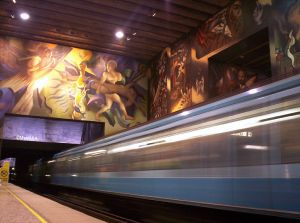
Santiago is the center of the nation's railroads. Highways and roads connect the city with the ports of San Antonio to the west and Valparaíso to the northwest, thus providing an outlet to the Pacific Ocean. The city has a subway system, and air services are provided by the international airport at Pudahuel and the airport at
Arturo Merino Benítez International Airport is Santiago's national and international airport with smaller domestic airports at Los Cerrillos, Lo Castillo and Tobalaba and a military airport at El Bosque.[8].
Trains operated by Chile's national railway, Empresa de los Ferrocarriles del Estado, connect Santiago to Temuco, in the central-southern part of the country. All such trains arrive and depart from Santiago's Estación Central ("Central Station").
"Metro" is the Santiago's subway transportation system. It currently has five operating lines. Two subway lines (Line 4 and 4A) and an extension of Line 2 were inaugurated during late 2005 and 2006. The system is still under expansion, and extensions to Lines 1 and 5 are going to be built by 2009.
Transantiago is the name for the city's public transport system. It was introduced on February 10 2007, and replaced the ad-hoc system run by thousands of independent bus operators. The new, integrated system, combines local bus lines, trunk bus lines, and the underground metro network allowing passengers to make bus-to-bus or bus-to-metro transfers. The new system has had an extremely rocky beginning, attracting all manner of criticisms from the public and the media resulting in several riots and public displays of outrage by frustrated passengers. Criticisms include that the network is not extensive enough, and that there simply aren't enough buses to serve the volume of people concerned.
Toll road, inter-urban free flow highways now connect the city's extremes, including the Vespucio Highway (which surrounds the city describing a semi-circle), Autopista Central (which crosses the city in a North-South direction), and the Costanera Norte (which runs from the eastern edge, in Las Condes to the international airport and the higways to Valparaíso on the western side of the city).
Santiago is served by two ports, San Antonio to the west and Valparaíso to the northwest.

Sister Cities
 Bogotá, Colombia
Bogotá, Colombia Buenos Aires, Argentina
Buenos Aires, Argentina Guayaquil, Ecuador
Guayaquil, Ecuador Kiev, Ukraine
Kiev, Ukraine Madrid, Spain
Madrid, Spain Managua, Nicaragua
Managua, Nicaragua Mexico City, Mexico
Mexico City, Mexico Miami, USA
Miami, USA Minneapolis, USA
Minneapolis, USA Paris, France
Paris, France Leningrad, Russia
Leningrad, Russia Plasencia, Spain
Plasencia, Spain Riga, Latvia
Riga, Latvia São Paulo, Brazil
São Paulo, Brazil San José, Costa Rica
San José, Costa Rica Ankara, Turkey
Ankara, Turkey
Trivia
Santiago is only a few dozen kilometers from the antipodes of Xi'an, China.
ReferencesISBN links support NWE through referral fees
- ↑ World Time Zones [url=http://www.world-time-zones.org/zones/chile-time.htm Chile Time] Retrieved October 21, 2007.
- ↑ World Time Zones [url=http://www.world-time-zones.org/zones/chile-summer-time.htm Chile Summer Time] Retrieved October 21, 2007.
- ↑ The American Hetitage Dictionary [http://dictionary.reference.com/help/ahd4.html Cornubation} Retrieved October 14, 2007.
- ↑ Chilean Cultural Heritage CorporationBrief report of the fire (Spanish)Retrieved October 20, 2007.
- ↑ 5.0 5.1 "National Geographic Atlas of the World, Eighth Edition, 2004"Santiago, Chile Retrieved October 20, 2007.
- ↑ 6.0 6.1 World Weather Information Service Santiago, Chile Retrieved September 04, 2007
- ↑ Encarta Air pollution Retrieved October 20, 2007.
- ↑ 8.0 8.1 Encyclopedia Britanica Santiago, Chile Retrieved October 20, 2007.
- ↑ World Book Encyclopedia Santiago, Chile Retrieved October 20, 2007.
- ↑ Expediciones Chile The Chilean Rodeo Retrieved October 21, 2007.
- ↑ Instituto Nacional de Estadística(INE), Chile 2002 Census
External links
- Santiago de Chile Daily Photo - A new photograph of Santiago every day.
- Municipality homepage
- Independent City Guide to Santiago, Chile
- Refuge of Mercy, shelter in Santiago
- A cultural and historical neighborhood, to visit in Santiago
Credits
New World Encyclopedia writers and editors rewrote and completed the Wikipedia article in accordance with New World Encyclopedia standards. This article abides by terms of the Creative Commons CC-by-sa 3.0 License (CC-by-sa), which may be used and disseminated with proper attribution. Credit is due under the terms of this license that can reference both the New World Encyclopedia contributors and the selfless volunteer contributors of the Wikimedia Foundation. To cite this article click here for a list of acceptable citing formats.The history of earlier contributions by wikipedians is accessible to researchers here:
The history of this article since it was imported to New World Encyclopedia:
Note: Some restrictions may apply to use of individual images which are separately licensed.
